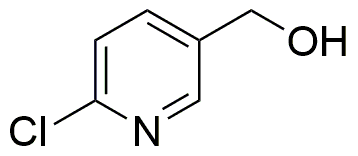6-Chloro-3-pyridinemethanol is widely utilized in research focused on:
- Pharmaceutical Development: This compound serves as a key intermediate in the synthesis of various pharmaceuticals, particularly in the development of anti-inflammatory and analgesic drugs.
- Agricultural Chemistry: It is used in the formulation of agrochemicals, enhancing the efficacy of pesticides and herbicides, thereby improving crop yields and pest management.
- Biochemical Research: Researchers leverage its properties to study enzyme inhibition and receptor binding, contributing to advancements in understanding biological pathways and disease mechanisms.
- Material Science: The compound is explored for its potential in creating novel materials, such as polymers with enhanced thermal and mechanical properties.
- Analytical Chemistry: It acts as a standard reference material in chromatographic techniques, aiding in the accurate analysis of complex mixtures in various samples.
General Information
Properties
Safety and Regulations
Applications
6-Chloro-3-pyridinemethanol is widely utilized in research focused on:
- Pharmaceutical Development: This compound serves as a key intermediate in the synthesis of various pharmaceuticals, particularly in the development of anti-inflammatory and analgesic drugs.
- Agricultural Chemistry: It is used in the formulation of agrochemicals, enhancing the efficacy of pesticides and herbicides, thereby improving crop yields and pest management.
- Biochemical Research: Researchers leverage its properties to study enzyme inhibition and receptor binding, contributing to advancements in understanding biological pathways and disease mechanisms.
- Material Science: The compound is explored for its potential in creating novel materials, such as polymers with enhanced thermal and mechanical properties.
- Analytical Chemistry: It acts as a standard reference material in chromatographic techniques, aiding in the accurate analysis of complex mixtures in various samples.
Documents
Safety Data Sheets (SDS)
The SDS provides comprehensive safety information on handling, storage, and disposal of the product.
Product Specification (PS)
The PS provides a comprehensive breakdown of the product’s properties, including chemical composition, physical state, purity, and storage requirements. It also details acceptable quality ranges and the product's intended applications.
Certificates of Analysis (COA)
Search for Certificates of Analysis (COA) by entering the products Lot Number. Lot and Batch Numbers can be found on a product’s label following the words ‘Lot’ or ‘Batch’.
Numéro de catalogue
Numéro de lot/série
Certificates Of Origin (COO)
This COO confirms the country where the product was manufactured, and also details the materials and components used in it and whether it is derived from natural, synthetic, or other specific sources. This certificate may be required for customs, trade, and regulatory compliance.
Numéro de catalogue
Numéro de lot/série
Safety Data Sheets (SDS)
The SDS provides comprehensive safety information on handling, storage, and disposal of the product.
DownloadProduct Specification (PS)
The PS provides a comprehensive breakdown of the product’s properties, including chemical composition, physical state, purity, and storage requirements. It also details acceptable quality ranges and the product's intended applications.
DownloadCertificates of Analysis (COA)
Search for Certificates of Analysis (COA) by entering the products Lot Number. Lot and Batch Numbers can be found on a product’s label following the words ‘Lot’ or ‘Batch’.
Numéro de catalogue
Numéro de lot/série
Certificates Of Origin (COO)
This COO confirms the country where the product was manufactured, and also details the materials and components used in it and whether it is derived from natural, synthetic, or other specific sources. This certificate may be required for customs, trade, and regulatory compliance.

